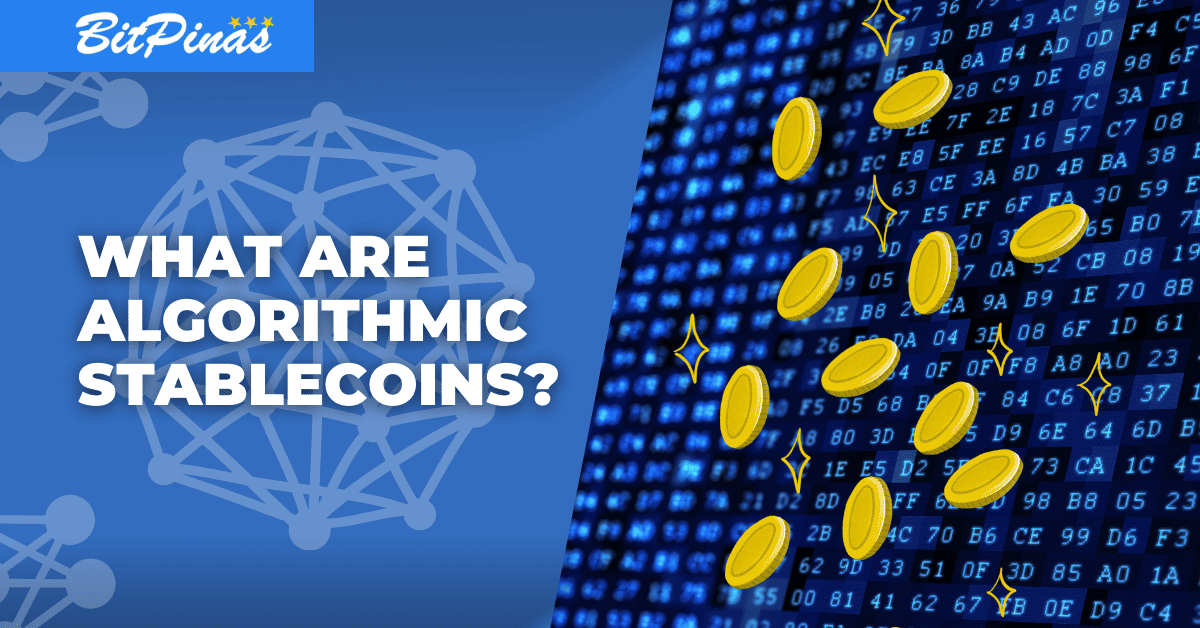What are Algorithmic Stablecoins?
Not all stablecoins are the same. It’s time to learn what makes algorithmic stablecoins unique and concerns about their “stability”.

The news of Terra (UST) crashing down shocked a lot of crypto investors and enthusiasts. Questions of how a stablecoin can be unstable arose: Are stablecoins safe to use especially when the market is down?
Stablecoins are categorized into three: Fiat-backed, crypto-backed and Algorithmic. Terra UST is an “algorithmic stablecoin”?
What are Algorithmic Stablecoins?
Algorithm-based stablecoins are cryptocurrencies that offer improved price stability without any collateral. There are no fiat or crypto attached to them to determine the price, like the case with USDT. Instead, it is based on algorithms. It offers considerably improved capital efficiency compared to other stablecoins.
Smart contracts are the basic framework of algorithmic stablecoins. Embedded in the smart contract are the rules to increase the supply in situations of deflation, or reduction in supply when in a reverse situation. Imagine it as an automated central bank trying to stabilize the economy.
For the case of Terra UST, it is designed to be fixed to the $1.00 value because of LUNA, its native token. When users burn LUNA, it mints UST in the process and when they mint Luna, it burns UST, as well. Theoretically, 1 UST worth $1.00 is equivalent to 1 LUNA. (Before the crash happened, more on that later.)
Governing bodies like decentralized autonomous organizations (DAOs) can have a consensus or vote on changing the rules of the smart contracts.
What is the Difference Between Algorithmic Stablecoins vs USDT/USDC?
Algorithmic stablecoins, on the other hand, are independent of any fiat or crypto collaterals. It is dependent on the structure of its smart contracts made by the developers behind the project.
Tether (USDT) and USD coin (USDC) are fiat-backed stablecoins. Fiat-backed stablecoins are crypto that depends on the amount of fiat, for instance, US Dollars, the project possesses. For instance, Tether should have a 1:1 ratio of US Dollars in their reserve.
But there are some algorithmic stablecoins that are considered hybrids of either fiat or crypto-backed but use algorithms to make the price of the stablecoin stable.
Notable examples of Algorithmic Stablecoins
Ampleforth (AMPL) is currently considered the longest-running algorithmic stablecoin. RAI is an ETH-backed stablecoin with a managed float regime. FEI is pegged to $1.00 USD. It powers many of the Tribe decentralized autonomous organization’s (DAO’s) services as its liquidity engine. FRAX attempts to be the first stablecoin protocol to implement design principles of both to create a highly scalable, trustless, extremely stable, and ideologically pure on-chain money.
Risks of Algorithmic Stablecoins
There are four factors that can affect an algorithmic stablecoin: Increase in supply, reducing supply, oracles and broken pegs.
Increase in Supply
When the price of the token increases above the predefined stable value, the protocol behind the stablecoin mints new tokens for increasing supply. To balance this, holders are also rewarded with bonds. Bonds are security for holders. In the case of UST, LUNA is given to holders as bonds.
Reducing Supply
Reducing supply leads to facilitating bonds. Bonds are sold in the open market for a lower price than the price of the stablecoin. These bonds are used as payments with a promise of returning one stablecoin in the future. Investors need to invest their confidence in the fact that these bonds will be paid off at a specific period of time.
Oracles
Oracle contracts are responsible for providing the price data related to stablecoins. Therefore, the algorithm verifies adjustments in the supply with knowledge of the price. But it can have questions on trust, honesty, and accuracy of the contracts.
Broken Pegs
Peg breaks run the maximum levels of risk for stablecoins. This risk is considered the worst scenario because it depends considerably on market confidence. Market confidence is an economic indicator that measures the degree of optimism that consumers feel about the overall state of the economy and their personal financial situation. Without this, a token or coin can gradually disappear into oblivion. If stablecoins experience two prominent peg breaks, they might have difficulties recovering.
Closing Statement
Algorithmic stablecoins have their pros and cons. It can be helpful to keep assets in traders’ portfolios instead of converting them into fiat. Algorithmic stablecoins can be a prototype of a complete decentralized system if the smart contracts are properly executed. But there are possible risks in placing assets into stablecoins that could possibly lose their values, especially for algorithmic stablecoins that have no collateral and are dependent on the smart contracts that it was built with.
Furthermore, researching algorithmic stablecoins is necessary before putting trust in their stability and safeguarding the investments that traders put into these coins.
This article is published on BitPinas: What are Algorithmic Stablecoins?
Disclaimer: BitPinas articles and its external content are not financial advice. The team serves to deliver independent, unbiased news to provide information for Philippine-crypto and beyond.





